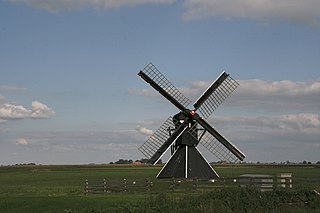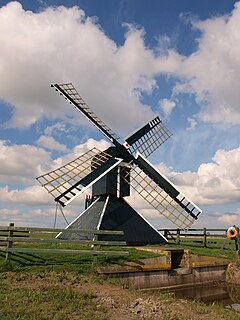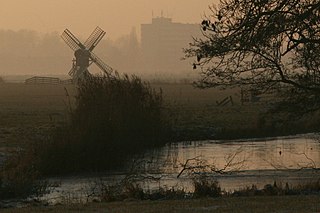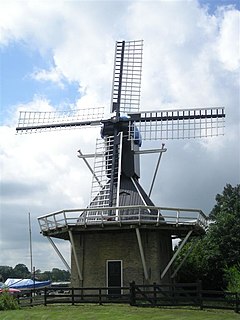
De Klaver or De Greate Klaver is a hollow post mill in Bolsward, Friesland, Netherlands which has been restored to working order. The mill is listed as a Rijksmonument, number 9860.

De Olifant is a smock mill in Burdaard, Friesland, Netherlands which has been restored to working order. The mill is listed as a Rijksmonument, number 35673.

De Heimerter Mole is a hollow post mill in Burgwerd, Friesland, Netherlands which has been restored to working order. The mill is listed as a Rijksmonument, number 39348.

Arkens is a Hollow Post mill in Franeker, Friesland, Netherlands which has been restored to working order. The mill is listed as a Rijksmonument, number 15710.

De Modderige Bol is a Hollow Post mill in Goëngahuizen, Friesland, Netherlands which has been restored to working order. The mill is listed as a Rijksmonument, number 34001.

Heechheim is a Hollow Post mill in Goëngahuizen, Friesland, Netherlands which has been restored to working order. The mill is listed as a Rijksmonument, number 33999.

Kramersmolen is a hollow post mill in Goutum, Friesland, Netherlands which was built in 2002. The mill is listed as a Rijksmonument, number 24508.

Molen Hoogland is a Hollow Post mill in Goutum, Friesland, Netherlands which was built in 2004. The mill is listed as a Rijksmonument, number 24521.

De Bird is a Hollow Post mill in Grou, Friesland, Netherlands which was built in the 18th century. The mill is also known as De Burd and Koopmans Molen. Although not in full working order, it can turn in the wind. It is listed as a Rijksmonument, number 22915.

De Oegekloostermolen is a hollow post mill in Hartwerd, Friesland, Netherlands which was built before 1830. The mill has been restored to working order. It is listed as a Rijksmonument, number 39347.

De Volharding is a smock mill in Jislum, Friesland, Netherlands which was built in 1872. The mill has been restored to working order and designated as being held in reserve in times of emergency. It is listed as a Rijksmonument, number 15632.

De Groene Molen is a hollow post mill in Joure, Friesland, Netherlands which was built c1800. The mill has been restored so that it can turn by wind. It is listed as a Rijksmonument, number 18208.

Terpzigt is a drainage mill in Marssum, Friesland, Netherlands. It is the smallest spinnenkop, a type of hollow post windmill. The mill is listed as a Rijksmonument, number 8625.

Teetlum, after a nearby terp, also known as Duivenhok 'dove coat' named after the polder it drained, is a drainage mill near the village of Tzum, Friesland, Netherlands. It is a hollow post windmill of the type called spinnenkop by the Dutch. The mill is listed as a Rijksmonument, number 15877 and can be used to drain the adjacent polder.

Fatum is a drainage mill near the village of Tzum, Friesland, Netherlands. It is a hollow post windmill of the type called "spinnenkop" by the Dutch. The mill is listed as a Rijksmonument, number 15876 and is in working order though it can no longer be used for drainage.

The spinnenkop of the Netherlands Open Air Museum in Arnhem is a small drainage mill originally located near Gorredijk, Friesland, Netherlands. It is a hollow post windmill that has been restored to working order.

't Zwaantje is a smock mill in Nijemirdum, Friesland, Netherlands which was built in 1878. The mill has been restored to working order. It is listed as a Rijksmonument.

De Schalsumermolen is a smock mill in Schalsum, Friesland, Netherlands which was built in 1801. The mill has been restored to working order. Used as a training mill, it is listed as a Rijksmonument.

De Skarrenmolen is a smock mill in Scharsterbrug, Friesland, Netherlands which was built in 1888. The mill has been restored to working order. It is listed as a Rijksmonument.

De Steenhuistermolen is a smock mill in Stiens, Friesland, Netherlands which was built in 1880. The mill is in working order and designated as being in reserve. It is listed as a Rijksmonument.





















